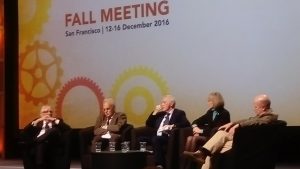December 14, 2016
One year after COP21: 3 things we learned
Posted by Timia Crisp
Today’s post is part of a series written by student bloggers from the AGU Fall Meeting.
By: Adele Kuzmiakova, Graduate Student, University College London, London
 Exactly one year ago, December 2015, marked a historical turning point in Paris where around 200 countries adopted the first-ever, bottom-up climate deal. The agreement provides a backdrop for a global action plan to reduce greenhouse gas emissions to constrain the global warming rate to 2°C. Yet the path to global sustainability is a work in progress and never done, and the overall trajectory makes much more sense when viewed through a rear-view mirror. Therefore, to celebrate the first anniversary of signing the agreement and examine its implications for scientific inquiry and policy-making, AGU hosted the session “U23A: The Path Forward from Paris, One Year Later”. I attended the session and walked away with 3 key insights.
Exactly one year ago, December 2015, marked a historical turning point in Paris where around 200 countries adopted the first-ever, bottom-up climate deal. The agreement provides a backdrop for a global action plan to reduce greenhouse gas emissions to constrain the global warming rate to 2°C. Yet the path to global sustainability is a work in progress and never done, and the overall trajectory makes much more sense when viewed through a rear-view mirror. Therefore, to celebrate the first anniversary of signing the agreement and examine its implications for scientific inquiry and policy-making, AGU hosted the session “U23A: The Path Forward from Paris, One Year Later”. I attended the session and walked away with 3 key insights.
The first take-home message emphasized the need to consider climate mitigation and adaptation together. Unlike 10 years ago, now it’s no longer a binary problem of choosing one or the other. It’s time to do both, accept things as they are, and work towards implementing adaptation solutions, which seek to reduce the negative impacts of climate change on local communities. Perhaps that means building elevated sidewalks in Miami as a response to rising sea levels, as Dr. Antonio Busalacchi, President of University Corporation for Atmospheric Research (UCAR), suggested. Perhaps that is reducing water usage in drought-stricken areas, such as California. Regardless of the local manifestation of climate change – whether it is having too much water, having too little water, or having too much runoff pollution – the local communities should make sure the adaptation measure serves their needs as best as it can.
At the same time, effective adaptation typically requires multi-community collaboration, which was the second insight I took home today. As a first-time attendee, I view the AGU Fall Meeting as a local form of a global phenomenon with opportunities to harness the collective perspectives of fellow participants. However, understanding and anticipating the impacts of climate change on human health, agriculture, or transportation will require taking yet another step outward by reaching out to communities outside of AGU. For instance, should we be worried when every summer seems to be a record-breaking summer? And how can we prepare for it? Most likely there are no quick answers to this perennial issue but multi-community collaborations can reveal insights and patterns that remain hidden in plain view. Specifically, as Dr. Margaret Leinen, President of AGU, mentioned, the AGU community needs to work with other communities, such as public health communities, epidemiologists, or insurance companies, to get a better sense of the magnitude of climate change impacts on all spheres of human life. What comes to my mind is a phrase “strength in numbers”, meaning that if we can get a larger number of people together to support an idea, the strength of that group and its actions will grow even stronger. Therefore, inter-community discussions have the potential to inspire a list of “How-Might-We…?” brainstorming adaptation topics and expand the solution set.
Finally, what resonated with me the most were closing remarks. They reminded us to adopt a sense of urgency when doing the right things for all the right reasons, such as ride-sharing, being economical with water, supporting adaptation research, or just about anything else to maintain progress towards the Paris goals. As Dr. Leinen expressed so well, “we don’t see the real cost of what we do.” Perhaps sometimes it is easy to get slightly myopic and become so rooted in what worked in the past that we lose foresight and discount future costs. Therefore, if we leave the conference with bias-towards-action and carry it over for the months ahead, it is going to set the course on the right track.


